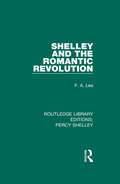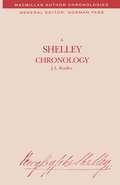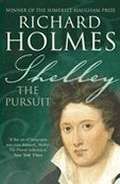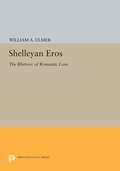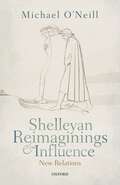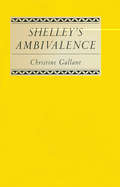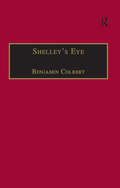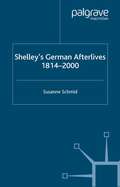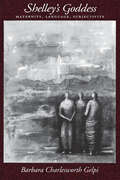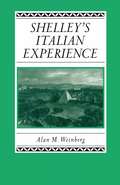- Table View
- List View
Shelley and the Musico-Poetics of Romanticism
by Jessica K. QuillinAddressing a gap in Shelley studies, Jessica K. Quillin explores the poet's lifelong interest in music. Quillin connects the trope of music with Shelley's larger formal aesthetic, political, and philosophical concerns, showing that music offers a new critical lens through which to view such familiar Shelleyan concerns as the status of the poetic, figural language, and the philosophical problem posed by idealism versus skepticism. Quillin's book uncovers the implications of Shelley's use of music by means of four musico-poetic concerns: the inherently interdisciplinary nature of musical imagery and figurative language; the rhythmic and sonoric dimensions of poetry; the extension of poetry into the performative realms of the theatre and drawing room through close links between most poetic genres and music; and the transformation of poetry into music through the setting and adaptation of poetic lyrics to music. Ultimately, Quillin argues, Shelley exhibits a fundamental recognition of an interdependence between music and poetry which is expressed in the form and content of his highly sonorous works. Equating music with love allows him to create a radical model in which poetry is the highest form of imaginative expression, one that can affect the mind and the senses at once and potentially bring about the perfectibility of mankind through a unique mode of visionary experience.
Shelley and the Romantic Revolution (RLE: Percy Shelley #3)
by F.A. LeaFirst published in 1945. In this work the author seeks to correct the misinterpretation and incorrect labelling of Shelley’s thought. While not neglecting Shelley as a poet, this book focuses on his contributions made to the general movement of political and philosophical thought of his era and by so doing his relevance to contemporary issues. This title will be of interest to students of literature.
Shelley and the Romantic Revolution (RLE: Percy Shelley #3)
by F.A. LeaFirst published in 1945. In this work the author seeks to correct the misinterpretation and incorrect labelling of Shelley’s thought. While not neglecting Shelley as a poet, this book focuses on his contributions made to the general movement of political and philosophical thought of his era and by so doing his relevance to contemporary issues. This title will be of interest to students of literature.
Shelley and Vitality
by S. RustonShelley and Vitality reassesses Percy Shelley's engagement with early nineteenth-century science and medicine, specifically his knowledge and use of theories on the nature of life presented in the debate between surgeons John Abernethy and William Lawrence. Sharon Ruston offers new biographical information to link Shelley to a medical circle and explores the ways in which Shelley exploits the language and ideas of vitality. Major canonical works are reconsidered to address Shelley's politicised understanding of contemporary scientific discourse.
The Shelley-Byron Circle and the Idea of Europe (Palgrave Studies in Cultural and Intellectual History)
by P. StockThis book investigates how Lord Byron, Percy Shelley, and their circle understood the idea of Europe. What geographical, cultural, and ideological concepts did they associate with the term? What does this tell us about politics and identity in early nineteenth-century Britain? In addressing these questions, Paul Stock challenges prevailing nationalist interpretations of Romanticism, but without falling prey to imprecise alternative notions of cosmopolitanism or "world citizenship." Instead, his book accounts for both the transnational and the local in Romantic writing, reassessing the period in terms of more complex, multi-layered identity politics.
A Shelley Chronology (Author Chronologies Series)
by J.L. BradleyJ.L. Bradley's chronology captures much of the drama and excitement of Shelley's life. This is an informative, often witty account which will be extremely valuable to all Shelley students, scholars and enthusiasts. A section on the Shelley circle is a particularly helpful supplement to the main body of the book.
Shelley: The Pursuit (PDF)
by Richard HolmesTreasure House Spelling Skills Teacher's Guides provide at-a-glance lesson planning to guide teachers through the activities in Treasure House Spelling Skills Pupil Books. Treasure House Spelling Skills Teacher's Guide 6: - provides at-a-glance planning with overviews, step-by-step instructions and answer keys for all Pupil Book units - offers ideas to enable all children to access learning in Support, Embed and Challenge sections - targets individual learning needs with photocopiable resources - maps units to the 2014 National Curriculum for English
Shelley: Selected Poems (Longman Annotated English Poets)
by Carlene Adamson Will Bowers Jack Donovan Cian Duffy Kelvin Everest Geoffrey Matthews Mathelinda Nabugodi Ralph Pite Michael RossingtonPercy Bysshe Shelley (1792–1822) was one of the major Romantic poets and wrote what is critically recognised as some of the finest lyric poetry in the English Language. In this volume, the editors have selected the most popular, significant and frequently taught poems from the six-volume Longman Annotated edition of Shelley’s poems. Each poem is fully annotated, explained and contextualised, along with a comprehensive list of abbreviations, an inclusive bibliography of material relating to the text and interpretation of Shelley’s poetry, plus an extensive chronology of Shelley’s life and works. Headnotes and footnotes furnish the personal, literary, historical and scientific information necessary for an informed reading of Shelley’s richly varied and densely allusive verse, making this an ideal anthology for students, classroom use, and anyone approaching Shelley’s poetry for the first time; however the level and extent of commentary and annotation will also be of great value for researchers and critics.
Shelley: Selected Poems (Longman Annotated English Poets)
by Kelvin EverestPercy Bysshe Shelley (1792–1822) was one of the major Romantic poets and wrote what is critically recognised as some of the finest lyric poetry in the English Language. In this volume, the editors have selected the most popular, significant and frequently taught poems from the six-volume Longman Annotated edition of Shelley’s poems. Each poem is fully annotated, explained and contextualised, along with a comprehensive list of abbreviations, an inclusive bibliography of material relating to the text and interpretation of Shelley’s poetry, plus an extensive chronology of Shelley’s life and works. Headnotes and footnotes furnish the personal, literary, historical and scientific information necessary for an informed reading of Shelley’s richly varied and densely allusive verse, making this an ideal anthology for students, classroom use, and anyone approaching Shelley’s poetry for the first time; however the level and extent of commentary and annotation will also be of great value for researchers and critics.
The Shelleyan Brontës: Mary and Percy Shelley in the Work of the Brontës (Palgrave Studies in the Enlightenment, Romanticism and Cultures of Print)
by J. E. YoungThis book explores the significant textual relationship between Mary and Percy Shelley and the early works of the Brontë siblings. Through a detailed examination of the Shelleyan narrative accessible to the Brontës from their childhood to their final novels, this study argues for a fresh perspective on the Brontës' engagement with the Shelleys in both their juvenilia and later seven novels. In this respect, the book considers the Brontës as readers rather than exclusively as writers, viewing them as a product of the early nineteenth-century literary marketplace which maintained affinities to Romanticism. Reading, rewriting, and appropriating the textual Shelleys was a fundamental vein stemming the Brontës’ writing from childhood, with Mary epitomising the model for what the sisters would eventually become: the female novelist.
Shelleyan Eros: The Rhetoric of Romantic Love
by William A. UlmerIn this work William Ulmer boldly advances our understanding of Shelley's concept of love by exploring eros as a figure for the poet's political and artistic aspirations. Applying a combination of deconstructive, historicist, and psychoanalytic approaches to six major poems, Ulmer follows the logic of the writing's rhetoric of love by tracing links between such elements as imagination, eros, metaphor, allegory, mirroring, repetition, death, and narcissism. Ulmer takes the mutual desire of self and antitype as a paradigm for rhetorical and social relations throughout Shelley and, in a significant departure from critical consensus, argues that his poetics were predominantly idealist.Ulmer demonstrates how the idealism of Shelleyan eros centers on a symbiosis of contraries organized as a dialectical variation of metaphor. In so doing, he contends that this idealism is both a rhetorical construct and revolutionary agency, and traces the failure of Shelley's visionary humanism to the gradual emergence of contradictions latent in his idealism. What emerges are new readings of individual texts and a reconsideration of the poet's imaginative development.Originally published in 1990.The Princeton Legacy Library uses the latest print-on-demand technology to again make available previously out-of-print books from the distinguished backlist of Princeton University Press. These editions preserve the original texts of these important books while presenting them in durable paperback and hardcover editions. The goal of the Princeton Legacy Library is to vastly increase access to the rich scholarly heritage found in the thousands of books published by Princeton University Press since its founding in 1905.
Shelleyan Reimaginings and Influence: New Relations
by Michael O'NeillThrough attuned close readings, this volume brings out the imaginative and formal brilliance of Percy Bysshe Shelley's writing as it explores his involvement in processes of dialogue and influence. Shelley recognizes that poetic individuality is the reward of connectedness with other writers and cultural influences. 'A great Poem is a fountain forever overflowing with the waters of wisdom and delight', he writes, 'and after one person and one age has exhausted all its divine effluence which their peculiar relations enable them to share, another and yet another succeeds, and new relations are ever developed, the source of an unforeseen and an unconceived delight' (A Defence of Poetry). He is among the major Romantic poetic exponents and theorists of influence, because of his passionately intelligent commitment to the onward dissemination of ideas and feelings, and to the unpredictable ways in which poets position themselves and are culturally positioned between past and future. The book has a tripartite structure. The first three chapters seek to illuminate his response to representative texts, figures, and themes that constitute the triple pillars of his cultural inheritance: the classical world (Plato); Renaissance poetry (Spenser and Milton); Christianity and, in particular, the concept of deity and the Bible. The second and major section of the book explores Shelley's relations and affinities with, as well as differences from, his immediate predecessors and contemporaries: Hazlitt and Lamb; Wordsworth; Coleridge; Southey; Byron; Keats (including the influence of Dante on Shelley's elegy for his fellow Romantic) and the great painter J. M. W. Turner, with whom he is often linked. The third section considers Shelley's reception by later nineteenth-century writers, figures influenced by and responding to Shelley including Beddoes, Hemans, Landon, Tennyson, and Swinburne. A coda discusses the body of critical work on Shelley produced by A. C. Bradley, a figure who stands at the threshold of twentieth-century thinking about Shelley.
Shelleyan Reimaginings and Influence: New Relations
by Michael O'NeillThrough attuned close readings, this volume brings out the imaginative and formal brilliance of Percy Bysshe Shelley's writing as it explores his involvement in processes of dialogue and influence. Shelley recognizes that poetic individuality is the reward of connectedness with other writers and cultural influences. 'A great Poem is a fountain forever overflowing with the waters of wisdom and delight', he writes, 'and after one person and one age has exhausted all its divine effluence which their peculiar relations enable them to share, another and yet another succeeds, and new relations are ever developed, the source of an unforeseen and an unconceived delight' (A Defence of Poetry). He is among the major Romantic poetic exponents and theorists of influence, because of his passionately intelligent commitment to the onward dissemination of ideas and feelings, and to the unpredictable ways in which poets position themselves and are culturally positioned between past and future. The book has a tripartite structure. The first three chapters seek to illuminate his response to representative texts, figures, and themes that constitute the triple pillars of his cultural inheritance: the classical world (Plato); Renaissance poetry (Spenser and Milton); Christianity and, in particular, the concept of deity and the Bible. The second and major section of the book explores Shelley's relations and affinities with, as well as differences from, his immediate predecessors and contemporaries: Hazlitt and Lamb; Wordsworth; Coleridge; Southey; Byron; Keats (including the influence of Dante on Shelley's elegy for his fellow Romantic) and the great painter J. M. W. Turner, with whom he is often linked. The third section considers Shelley's reception by later nineteenth-century writers, figures influenced by and responding to Shelley including Beddoes, Hemans, Landon, Tennyson, and Swinburne. A coda discusses the body of critical work on Shelley produced by A. C. Bradley, a figure who stands at the threshold of twentieth-century thinking about Shelley.
Shelley's Ambivalence (Studies in Romanticism)
by Christine GallantA study of Shelley's poetry, approaching it from the viewpoint of contemporary Jungian analytical psychology that incorporates the theories of Melanie Klein and D.W. Winnicott. Material that relates to the earliest stages of the ego's development - to the pre-Oedipal situation - are used.
The Shelleys and the Brownings: Textual Re-Imaginings and the Question of Influence (English Association Monographs: English at the Interface #9)
by Rieko SuzukiThis book is about the intertextual relationships between the works of the Shelleys and the Brownings. While a lot of research has been done on the relationship between Percy Bysshe Shelley and Robert Browning, virtually nothing has been said about the links between Mary Shelley and Robert Browning, and very little on the connections between the Shelleys and Elizabeth Barrett Browning. Rieko Suzuki seeks to address this blind spot by focusing on three areas in particular: firstly, the way that Browning’s later poems reflect back on and re-engage with Shelley’s work; secondly, Mary Shelley’s influence on Browning’s early poems; and thirdly, Shelley’s presence in and influence on Elizabeth Barrett Browning’s writing. In mapping out the various ways in which texts relate to other texts, the book also identifies a number of important thematic threads that run throughout the work of all four writers. These include theories of history and historical consciousness, providing a further dimension to the question of ‘influence’. They also include ideas about exile, gender, liberal politics and cultural heritage, central to almost all the texts discussed here, as the Shelleys and the Brownings, in different ways and in varying contexts, tried to negotiate the possibility of a more tolerant and resilient social, political and cultural environment.
Shelley's Broken World: Fractured Materiality and Intermitted Song (Liverpool English Texts and Studies #89)
by Bysshe CoffeyShortlisted for the University English Book Prize 2022Shelley’s Broken World is a provocative and profound reassessment of Shelley’s poetic art and thought. Bysshe Inigo Coffey returns to a peculiarity of Shelley’s expressive repertoire first noticed by his Victorian readers and editors: his innovatory use of pauses, which registered as irregularities in ears untuned to his innovations. But his pauses are more than a quirk; various intermittences are at the centre of Shelley’s artistry and his thought. This book aims to transform the philosophical, scientific, and aesthetic contexts in which Shelley is positioned. It offers a ground-breaking analysis of his reading, and is the first study to refer to and include images of the unpublished ‘Marlow List’, a record of the books Shelley left behind him on his departure for Italy in 1818. Shelley’s prosody grew to articulate his sense that actuality is experienced as ruptured and fractured with gaps and limit-points. He shows us the weakness of the actual. As we approach the bicentenary of the poet’s death, Shelley’s Broken World provides an exciting new beginning for the study of a major Romantic poet, the history of materialism, and prosody.
Shelley's Eye: Travel Writing and Aesthetic Vision (The Nineteenth Century Series)
by Benjamin ColbertPercy Bysshe Shelley joined the deluge of sightseers that poured onto the Continent after Napoleon's defeat in 1814, and over the next eight years Shelley followed major travelling trends, visiting Switzerland in 1816 and Italy from 1818. Shelley's Eye is the first study to address Shelley's participation in the travel culture of Post-Napoleonic Europe, and the first to consider Shelley as an important travel writer in his own right. This book is informed by original research on a wide range of period travel writings, including Mary Shelley and Shelley's neglected collaboration, History of a Six Weeks' Tour (1817), in which 'Mont Blanc' first appeared. Fully responsive to the culture of travel, Shelley's travel prose and poetry form fascinating conversations with major Romantic travellers like Byron, Wollstonecraft, and Wordsworth, as well as lesser-known but widely read travel writers of the day, including Morris Birkbeck, Charlotte Eaton, and John Chetwode Eustace. In this provocative study, Benjamin Colbert demonstrates how the Grand Tour remains a vital cultural metaphor for Shelley and his contemporaries, under pressure from mass travel and popular culture. Shelley's travel prose and 'visionary' poetry explore motives of perception underlying travel discourse and posit an authentic 'aesthetic vision' that reconfigures social, historical, and political meanings of 'sights' from the perspective of an ideal tourist-observer. Shelley's Eye offers a new perspective on Shelley's intellectual history. It is also a timely and important contribution to recent interdisciplinary scholarship that aims to re-evaluate Romantic idealism in the context of physical, experiential, or material cultural practices.
Shelley's Eye: Travel Writing and Aesthetic Vision (The Nineteenth Century Series)
by Benjamin ColbertPercy Bysshe Shelley joined the deluge of sightseers that poured onto the Continent after Napoleon's defeat in 1814, and over the next eight years Shelley followed major travelling trends, visiting Switzerland in 1816 and Italy from 1818. Shelley's Eye is the first study to address Shelley's participation in the travel culture of Post-Napoleonic Europe, and the first to consider Shelley as an important travel writer in his own right. This book is informed by original research on a wide range of period travel writings, including Mary Shelley and Shelley's neglected collaboration, History of a Six Weeks' Tour (1817), in which 'Mont Blanc' first appeared. Fully responsive to the culture of travel, Shelley's travel prose and poetry form fascinating conversations with major Romantic travellers like Byron, Wollstonecraft, and Wordsworth, as well as lesser-known but widely read travel writers of the day, including Morris Birkbeck, Charlotte Eaton, and John Chetwode Eustace. In this provocative study, Benjamin Colbert demonstrates how the Grand Tour remains a vital cultural metaphor for Shelley and his contemporaries, under pressure from mass travel and popular culture. Shelley's travel prose and 'visionary' poetry explore motives of perception underlying travel discourse and posit an authentic 'aesthetic vision' that reconfigures social, historical, and political meanings of 'sights' from the perspective of an ideal tourist-observer. Shelley's Eye offers a new perspective on Shelley's intellectual history. It is also a timely and important contribution to recent interdisciplinary scholarship that aims to re-evaluate Romantic idealism in the context of physical, experiential, or material cultural practices.
Shelley's Frankenstein (Reader's Guides)
by Graham AllenMary Shelley's classic gothic novel, Frankenstein, is one of the most widely studied novels in English Literature. Due to its key position in the canon and its wide cultural influence, the novel has been the subject of many interpretations, which require some guidance to navigate. This book offers an authoritative, up-to-date guide for students, introducing its context, language, themes, criticism and afterlife, leading them to a more sophisticated understanding of the text. Graham Allen places Frankenstein in its historical, intellectual and cultural contexts, offering analyses of its themes, style and structure, providing exemplary close readings, and presenting an up-to-date account of its critical reception. It also includes an introduction to its substantial history as an adapted text on stage and screen and its wider influence in film and popular culture. It includes points for discussion, suggestions for further study and an annotated guide to relevant reading.
Shelley's German Afterlives: 1814-2000 (Nineteenth-Century Major Lives and Letters)
by S. SchmidSchmid shows how reception processes work across linguistic, national, and cultural boundaries, taking the English Romantic poet Shelley's German reception as a case study. It also highlights Anglo-German literary and cultural relations of the nineteenth and twentieth centuries and supplies a theoretical framework for further analysis.
Shelley's Goddess: Maternity, Language, Subjectivity
by Barbara Charlesworth GelpiThe subject of Gelpi's new book is the importance of the mother-infant relationship in Percy Bysshe Shelly's poetry and life. However, her book also uses Shelley as a touchstone by which to examine the rich historical and theoretical issues relevant to motherhood in the Romantic period. Gelpi offers a detailed account of the historical rise in attention paid to mothering, the changing cultural attitudes towards the role of the mother, and the resulting effect on the nature of family life. She further discusses the psychoanalytic, Marxist, and developmental approaches to the mother/infant relationship, particularly to the connection each makes between that relationship and the acquisition of language. By combining psychoanalytic, poststructuralist and feminist theory with extensive biographical material on Shelley and information on the position of mothers in England after 1790, Gelpi offers an important reassessment of Shelley's avowed feminism and the failure of his utopian vision.
Shelley's Intellectual System and its Epicurean Background (Studies in Major Literary Authors)
by Michael VicarioScholars do not agree on how best to describe Shelley’s philosophical stance. His work has been variously taken to be that of a skeptic or a skeptical and subjective idealist. The study presents a new interpretation of Shelley’s thinking – an interpretation that places ‘intellectual system’ squarely within the Epicurean tradition of Lucretius, casting both poets as theistic empiricists. To establish Shelley as working in the Epicurean tradition, this study explores Lucretius’ De Rerum Natura as edited, translated and interpreted by two Epicurean scholars roughly contemporary with Shelley: Gilbert Wakefield and John Mason Good. These scholars rehabilitated Lucretius by drawing on three major seventeenth-century thinkers, Pierre Gassendi, Ralph Cudworth and Nicholas Malebranche. Like Shelley, each of these thinkers rejected the reduction of philosophy to mechanical and atomistic elements, a reduction which Shelley referred to as ‘materialism’ or ‘popular dualism’. What Shelley rejected is a clue to what he embraced: a fusion of Enlightenment Rationalism with British Empiricism. Such a fusion is the distinguishing mark of the work of Sir William Drummond, the only contemporary philosopher that Shelley consistently praised. This is the tradition within which Shelley ultimately stands – one that brings into balance what is given to the mind a priori and what the mind creates.
Shelley's Intellectual System and its Epicurean Background (Studies in Major Literary Authors)
by Michael VicarioScholars do not agree on how best to describe Shelley’s philosophical stance. His work has been variously taken to be that of a skeptic or a skeptical and subjective idealist. The study presents a new interpretation of Shelley’s thinking – an interpretation that places ‘intellectual system’ squarely within the Epicurean tradition of Lucretius, casting both poets as theistic empiricists. To establish Shelley as working in the Epicurean tradition, this study explores Lucretius’ De Rerum Natura as edited, translated and interpreted by two Epicurean scholars roughly contemporary with Shelley: Gilbert Wakefield and John Mason Good. These scholars rehabilitated Lucretius by drawing on three major seventeenth-century thinkers, Pierre Gassendi, Ralph Cudworth and Nicholas Malebranche. Like Shelley, each of these thinkers rejected the reduction of philosophy to mechanical and atomistic elements, a reduction which Shelley referred to as ‘materialism’ or ‘popular dualism’. What Shelley rejected is a clue to what he embraced: a fusion of Enlightenment Rationalism with British Empiricism. Such a fusion is the distinguishing mark of the work of Sir William Drummond, the only contemporary philosopher that Shelley consistently praised. This is the tradition within which Shelley ultimately stands – one that brings into balance what is given to the mind a priori and what the mind creates.
Shelley's Italian Experience (Studies in Romanticism)
by Alan M. WeinbergFocusing on Shelley's 'Italian experience', the present study both addresses itself to the living context which nurtured Shelley's creativity, and explores a neglected but essential component of his work. The poet's four years of self-exile in Italy (1818-1822) were, in fact, the most decisive of his career. As he responded to Italy, his poetry acquired a new subtlety and complexity of vision. Endowed with remarkably keen powers of absorption, the poet imaginatively reshaped the rich cultural heritage of Italy and the vital qualities of its landscape and climate.

